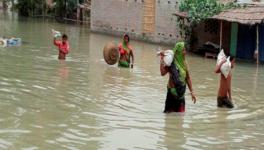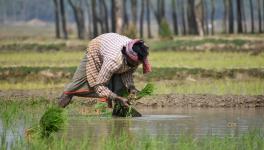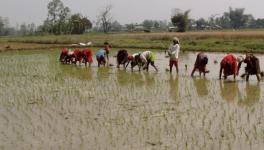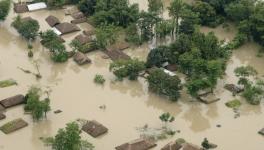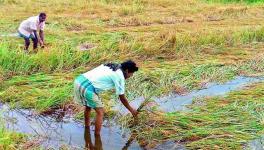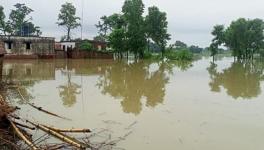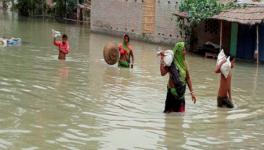Bihar: Surplus Rainfall Mounts Problems for Paddy Growing Farmers, as Waterlogging Damages Seedlings
Representational use only.
Patna: Unexpected surplus rainfall in June in Bihar, considered as an impact of climate change, has created problems for Kamlesh Singh, a marginal farmer as his paddy seedlings were fully damaged because of waterlogging in his field.
Singh was forced to pull out the sown paddy to prepare seedlings for second time in two weeks. Now, he fears threat to his paddy seedlings once again as the local weather office has forecast more rainfall in July first week.
The state had received 339.5 millimetres of rainfall — 119% surplus than normal in June 2021.It had received surplus rainfall (305.9 mm) in June 2020, too. Weather experts have termed excess rainfall in the early stage of the monsoon as an unusual phenomenon linked with climate change.
Singh, a resident of Jamharu village near Paliganj in Patna district, isn’t fully aware of the impact of climate change, but what he experienced in June this year, soon after the excess rainfall for the second consecutive year, is that the change in climate cycle is bound to hit paddy cultivation.
Singh is among thousands of farmers, mostly marginal and small, who were upbeat in mid-June when the monsoon arrived on time followed by heavy rainfall. But, their happiness did not last long due to excess rainfall, which is not appropriate for preparing paddy seedlings in the field.
Paddy sowing has been going on in full swing in large parts of Bihar since last month. But, a majority of farmers are now facing the problem of damaged seedlings.
“Farmers are not used to this is a problem of plenty of rainfall in early monsoon. It is the result of change in weather conditions in recent years. Earlier, farmers were facing drought or poor rainfall,” Suresh Rai, a marginal farmer in Vaishali district, said.
Abdus Sattar, agro-meteorologist at the Rajendra Prasad Central Agricultural University in Samastipur district, said timely arrival of monsoon and continuous low pressure feeding the monsoon activity has caused the surplus rainfall. “We have been researching on what is causing extreme rainfall in June, it appears to be related with climate change”, he added.
As per a vulnerability study conducted by Indian Council of Agricultural Research (ICAR) under the aegis of National Innovations in Climate Resilient Agriculture (NICRA) project, Bihar is most vulnerable to climate change impacts. Available evidence shows that there is high probability of increase in the frequency and intensity of climate-related natural hazards and increase in potential threats due to climate change-induced natural disasters in Bihar.
Farmers in Bihar are heavily dependent on monsoon rains for kharif crops, mainly paddy, which is a water-intensive crop. With surplus rainfall in June itself, the farmers are facing difficulty to prepare seedlings and more surplus rainfall in July will be a challenge for transplanting paddy.
Surplus rainfall in the catchment areas of major rivers, including Gandak, Burhi Gandak, Bagmati and Koshi, in the state and neighbouring Nepal, has resulted in floods in low lying areas in nearly a dozen districts. Thousands of people in hundreds of marooned villages have been displaced and have been forced to take shelter on nearby high-rise embankments and national highways.
Read Also: Bihar: Thousands of Maize Growers in Distress After Lockdown, Untimely Rains
Weather scientists at India Meteorological Department (IMD), Patna, said that 36 of 38 districts of the state received excess rainfall than normal in June. Only two districts -- Kishanganj and Purnea -- received less than the normal rainfall.
They pointed that till last year, either the monsoon was delayed or there was poor or erratic rainfall in June. As per IMD data, Bihar received 97.8 mm rains in 2019, nearly 40% less than normal; 100.3 mm in 2018; 84.6 mm in 2017; 128.7 mm in 2016 and 123.6 mm in 2015.
According to annual rainfall reports (Rainfall Statistics of India) of IMD, Bihar gets 1,027.6 mm rainfall in a normal monsoon year and its average annual rainfall, including pre-monsoon, monsoon, post-monsoon and winter, is 1,205.6 mm.
This year, Bihar has already received more than 30% of total normal rainfall till June 30. The monsoon season is from June to September.
From 2012 to 2018, the state received deficient rainfall. In 2018, the monsoon was poor as there was a rainfall deficit of 25%. This forced the state government to declare drought in 24 of 38 districts. Paddy production was impacted and dropped to 74.15 lakh tonnes against the target of 102 lakh tonnes in 2018-19, according to Agriculture Department figures.
R K Soane, Vice chancellor of Bihar Agriculture University, Sabour, Bhagalpur, said after surplus rainfall in June, now farmers need normal rainfall with some interval so that no harm or damage is caused to paddy cultivation. “More surplus rainfall is not good for farmers”, he added.
Agriculture is the backbone of Bihar’s economy, employing 81% of the workforce and generating nearly 42% of the state’s domestic product, according to state government’s figures.
Get the latest reports & analysis with people's perspective on Protests, movements & deep analytical videos, discussions of the current affairs in your Telegram app. Subscribe to NewsClick's Telegram channel & get Real-Time updates on stories, as they get published on our website.










